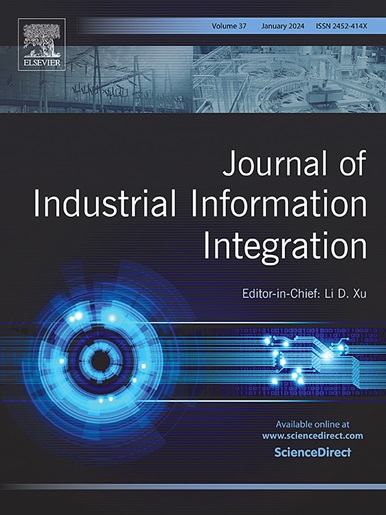工业物联网中的协同任务调度:进化算法和深度强化学习的比较研究
IF 10.4
1区 计算机科学
Q1 COMPUTER SCIENCE, INTERDISCIPLINARY APPLICATIONS
引用次数: 0
摘要
从工业信息集成工程(IIIE)的角度来看,工业物联网(IIoT)是一个统一的框架,通过云边缘设备协同,集成云、边缘和制造资源,实现高度灵活和协同的生产流程。工业物联网中的协同任务调度是指将制造和计算任务分配给异构资源,以最大限度地减少整体任务的完成时间和能耗。然而,复杂的任务依赖关系和资源配置的异构性使得调度问题非常具有挑战性。为了解决这个问题,我们在三个代表性的工业物联网调度场景中对七种进化算法(EAs)和七种深度强化学习(DRL)方法进行了全面评估:制造任务调度(MTS),计算任务调度(CTS)和混合任务调度(HTS)。为了研究算法设计的影响,我们提出了两种类型的算法公式:显式公式(EF),其中算法输出直接对应于决策变量,以及隐式公式(IF),其中输出表示指导任务分配的启发式因素。对于每个场景,我们构建了三个尺度的调度实例,并在两种形式下评估了所有14种方法。结果表明,ea具有更稳定的性能,而drl具有更强的泛化能力和更快的推理速度,特别是在大规模或动态场景下。此外,隐式公式通常会在两个算法类之间带来更好的解质量。这些发现为工业物联网环境下的算法选择和设计提供了有价值的见解,并强调了制定策略在影响优化结果方面的重要性。本文章由计算机程序翻译,如有差异,请以英文原文为准。
Collaborative task scheduling in IIoT: A comparative study of evolutionary algorithms and deep reinforcement learning
From the perspective of industrial information integration engineering (IIIE), the Industrial Internet-of-Things (IIoT) serves as a unified framework that integrates cloud, edge, and manufacturing resources through cloud–edge–device collaboration, enabling highly flexible and collaborative production processes. Collaborative task scheduling in IIoT refers to assigning manufacturing and computational tasks to heterogeneous resources to minimize the overall task makespan and energy consumption. However, the presence of complex task dependencies and the heterogeneity of resource configurations make the scheduling problem highly challenging. To address this, we conduct a comprehensive evaluation of seven evolutionary algorithms (EAs) and seven deep reinforcement learning (DRL) methods across three representative IIoT scheduling scenarios: manufacturing task scheduling (MTS), computational task scheduling (CTS), and hybrid task scheduling (HTS). To investigate the effect of algorithm design, we propose two types of algorithm formulations: explicit formulation (EF), where the algorithm outputs correspond directly to decision variables, and implicit formulation (IF), where outputs represent heuristic factors guiding task assignment. For each scenario, we construct scheduling instances of three scales and evaluate all 14 methods under both formulations. The results demonstrate that EAs offer more stable performance, while DRLs exhibit stronger generalization and faster inference, especially in large-scale or dynamic scenarios. Moreover, the implicit formulation often leads to better solution quality across both algorithm classes. These findings provide valuable insights for algorithm selection and design in IIoT environments and highlight the importance of formulation strategies in influencing optimization outcomes.
求助全文
通过发布文献求助,成功后即可免费获取论文全文。
去求助
来源期刊

Journal of Industrial Information Integration
Decision Sciences-Information Systems and Management
CiteScore
22.30
自引率
13.40%
发文量
100
期刊介绍:
The Journal of Industrial Information Integration focuses on the industry's transition towards industrial integration and informatization, covering not only hardware and software but also information integration. It serves as a platform for promoting advances in industrial information integration, addressing challenges, issues, and solutions in an interdisciplinary forum for researchers, practitioners, and policy makers.
The Journal of Industrial Information Integration welcomes papers on foundational, technical, and practical aspects of industrial information integration, emphasizing the complex and cross-disciplinary topics that arise in industrial integration. Techniques from mathematical science, computer science, computer engineering, electrical and electronic engineering, manufacturing engineering, and engineering management are crucial in this context.
 求助内容:
求助内容: 应助结果提醒方式:
应助结果提醒方式:


